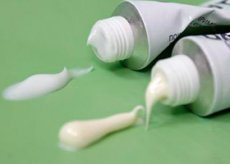
All iLive content is medically reviewed or fact checked to ensure as much factual accuracy as possible.
We have strict sourcing guidelines and only link to reputable media sites, academic research institutions and, whenever possible, medically peer reviewed studies. Note that the numbers in parentheses ([1], [2], etc.) are clickable links to these studies.
If you feel that any of our content is inaccurate, out-of-date, or otherwise questionable, please select it and press Ctrl + Enter.
Ointments for gout
Medical expert of the article
Last reviewed: 06.07.2025

In the International Classification of Medicines (ATC), among the drugs against gout (code M04A), external agents for the treatment of this disease are not listed, and any ointment for gout is classified as a drug for external use for joint and muscle pain (ATC code – M02A).
Indications for the use of ointments for gout are the manifestation of symptoms of an exacerbation of the disease: redness, swelling, inflammation and pain in the affected joints.
It is difficult to list absolutely all the names of ointments for gout, that is, local remedies for reducing the intensity of symptoms of gout attacks. In clinical practice, effective ointments for gout containing non-steroidal anti-inflammatory drugs (NSAIDs) are most often recommended: Diclofenac, Ibuprofen, Ketoprofen, Indomethacin, Piroxicam.
Pain Relief Ointment for Gout
To relieve pain and reduce inflammation, ointments and gels based on Diclofenac (Diclofenacol, Dicloran, Diclac-gel, Voltaren emulgel), Ibuprofen (Deep Relief, Dolgit, Ibalgin), Ketoprofen (Ketonal, Fastum gel, Febrofid, Ultrafastin, Bystrumgel), Piroxicam (Finalgel), etc. are used.
For more information on how the listed ointments work, what contraindications they have for use, side effects and interactions with other drugs, as well as whether it is possible to use ointments for gout during pregnancy and whether there is an overdose of ointments for gout, read the article - Ointment for joint pain
In addition, it is necessary to mention the ointment Indomethacin (Metindol), which is also a non-steroidal anti-inflammatory drug. So this ointment will also help relieve pain and inflammation of soft tissues near the affected joints during an exacerbation of gout. Its pharmacodynamics, method of application and all other pharmacological characteristics are similar to other NSAIDs (see the article recommended above).
Butadion ointment for gout is not currently prescribed, although its active ingredient - NSAID of the butylpyrazolidone group phenylbutazone - has an anti-inflammatory, anti-edematous and analgesic effect in diseases such as rheumatoid arthritis and ankylosing spondylitis. Butadion should not be used for gout: European specialists came to such conclusions back in the mid-1950s after clinical studies of the effect of phenylbutazone on renal clearance of urates and excretion of uric acid in patients with gouty arthritis.
By the way, Vishnevsky ointment was used for gout before, when there were no modern non-steroidal anti-inflammatory drugs for local use. Vishnevsky ointment is an antiseptic and is used to treat purulent ulcers, wounds, abscesses, burns and frostbite with necrosis. Read more - Vishnevsky Liniment (Vishnevsky Ointment)
Fullflex cream for gout
The Internet advertises Fulflex cream for gout (produced in the Russian Federation), which is not included in the list of pharmacopoeial drugs, but is recommended for rheumatic and muscle pain.
The pharmacodynamics of this product are determined by the components included in its composition: extracts of harpagophytum tubers (fragrant martinia), willow and birch bark, horse chestnut; oils - juniper, eucalyptus, sage, fir and grape seed (the latter improves blood circulation), as well as vitamins (tocopherol, nicotinic acid and rutin).
Manufacturers of Fulflex focus on the extract of harpagophytum, which has analgesic and anti-inflammatory properties. This plant is used in such oral medications as Revmagerb, Sustamar, Harpagin and Revmafit, recommended for degenerative joint pathologies, including osteochondrosis and spondyloarthrosis.
Contraindications to the use of Fulflex cream are individual intolerance to the substances included in its composition, as well as pregnancy and breastfeeding.
Directions for use and dosage: Apply the product to the affected areas twice a day for a month and massage gently.
Possible side effects include allergic reactions.
Storage conditions include absence of direct light and room temperature, and the shelf life of the cream is 24 months.
 [ 6 ]
[ 6 ]
Chinese ointment for gout
Chinese ointment for gout Tiger Balm White is actually a balm for muscle pain. This product contains Vaseline (36%) with the addition of menthol, camphor, mint oil, cloves and eucalyptus. It is applied to the sore spot and rubbed into the skin. The product works due to the reflex blood flow, improving tissue trophism.
Most products positioned as Chinese ointment for gout often contain extracts from plants used in traditional Eastern medicine: jujube (Chinese date), amla (Indian gooseberry), aconite and rhubarb roots, leaves of the Terminalia tree, etc. These substances help reduce pain and swelling in joint pain, but the accompanying instructions do not contain enough reliable information and mechanisms of their therapeutic action.
Therefore, when choosing an ointment for gout, it is better to consult with your doctor.
More useful information in the material - Overview of methods for treating gout

